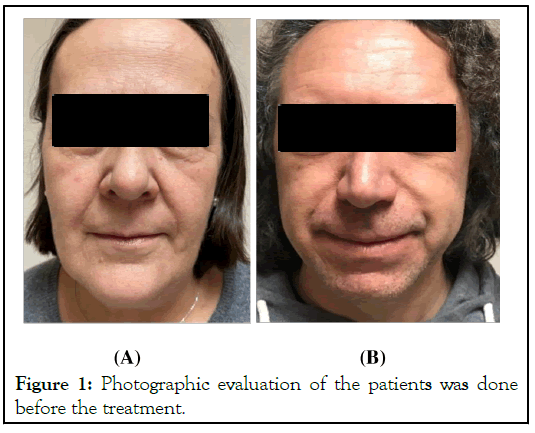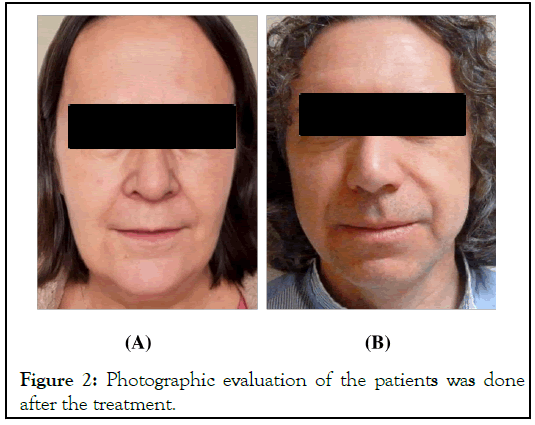Journal of Clinical & Experimental Dermatology Research
Open Access
ISSN: 2155-9554
+44 1478 350008
ISSN: 2155-9554
+44 1478 350008
Case Report - (2023)Volume 14, Issue 6
Background: Several known factors contribute to the visible signs of facial aging. Changes in dentition and bony architecture, facial fat loss, diminished dermal thickness, and loss of dermal and subcutaneous support structures may result in folds and hollows that age the face. Filling age-related deficits of the face with fillers, such as hyaluronic acid, restores a more youthful appearance without the need for invasive techniques. Objectives: Definisse™ fillers are stable and long-lasting owing to their higher G’ compared to other benchmarked fillers; this property allows for excellent projection with a small amount of product used in patients with moderate to severe signs of aging. This paper is the first report on the clinical effects of Definisse™ fillers. Methods: We present two cases demonstrating the safety and efficacy of combined full-face treatment using different Definisse™ fillers with different injection techniques and devices. Results: Both patients tolerated the procedure well and showed visible signs of appearance improvement. Conclusion: Definisse™ fillers represent a set of HA fillers that can be considered as an option for patients with moderate to severe signs of aging who wish to achieve a more youthful appearance.
Facial rejuvenation; Definisse™ fillers; Patients; Injection techniques
Changes in dentition and the faces’ bony architecture, facial fat atrophy leading to diminished dermal thickness, and loss of dermal and subcutaneous support structures may result in folds and hollows that age the face [1]. Filling subcutaneous concavities of the face with fillers, such as Hyaluronic Acid (HA), helps restore volume deficits without invasive techniques [2]. Studies have shown that commercially available HA fillers have a variety of properties, namely concentration, gel-to-fluid ratio, HA gel concentration, degree of HA modification, percentage of cross-linking, swelling, modulus, and particle size [3]. Much attention has been given to filler rheological parameters as the key differentiating factors affecting injector choice and specific indications of HA fillers. These properties describe how HA fillers integrate into soft tissue and their capacity to modify the volume of the treated layers [4]. Definisse™ fillers are among the HA fillers that have been extensively described in the literature. These fillers are manufactured using the unique eXcellent Threedimensional Reticulation (XTR™) technology that renders it stable, longer lasting, and provides prominent projection with a small amount of product owing to their higher G’ compared to other fillers with the same indications [5]. When compared with other fillers with the same HA concentrations, Definisse™ fillers have a relatively higher modulus of elasticity or G’. This implies that this class of fillers has more lifting and volumizing capacity without being granular. Likewise, these fillers were found to be more degradation resistant. These properties make this line of fillers preferable in cases where patients require longer-lasting effects with a minimal amount of product [5].
The full-face approach combines contouring, augmentation, and reshaping of various regions of the face using fillers of different properties to achieve optimal aesthetic outcomes [6]. In this pilot study, we aimed to clinically evaluate the safety and efficacy of combined full-face treatment with the use of three filler types of the Definisse™ family, namely Core, Restore and Touch, using distinctive injection techniques at various sites of the face.
We report two patients with no previous history of facial injectables or surgery who presented with moderate to severe signs of facial aging. All procedures conducted here were in accordance with the ethical standards of Dameto Clinics International and with the Helsinki Declaration of 1975, as revised in 2008. Informed, written consent was received from all patients from whom photographs were taken. Patient A is a 55- year-old female who complained of hollow temples and midface and prominent facial lines along the nasolabial area and marionette lines. Patient B is a 48-year-old male who came in for treatment of under-eye darkness and noticeable jowling of the cheeks. They report Body Mass Indexes (BMI) within normal limits and were both in apparent good health (American Society of Anesthesiologists (ASA) Classification 1). The steps taken in this study were in accordance with the ethical standards of Dameto Clinics International and with the Helsinki Declaration of 1975, as revised in 2008. Patients were requested to sign an informed, written consent.
Definisse™ fillers were used in various areas and planes of the face to address different concerns:
• Definisse Core was injected in the periosteal plane (0.5-1 mL, 27G needle, bolus) to volumize and restore areas of the face with apparent bone resorption (e.g., temples)
• Definisse Restore was injected in the subcutaneous plane (0.5-1 mL, 25G cannula, fanning technique) to refine facial contouring and restore volume loss
• Definisse Touch was injected subdermally (1 mL, 25G cannula, nasolabial fold and/or tear trough injections or, for the lip only, 30G needle, linear retrograde technique) to improve skin hydration, reduce facial wrinkles and enhance the lips.
The two patients received their first treatment at day 0 and touch-up treatments between 2 weeks and 1 month after the first treatment session. Before and after photographs were used to document changes in gross appearance from the onset and after 6 months of injection. Investigator- and subject-reported Global Aesthetic Improvement Scales (GAIS) were likewise assessed.
A combination approach using different injection techniques in different injection planes using Definisse™ fillers led to visible improvements in patients with moderate to severe aging signs [6]. Photographic evaluation of the patients was done before the treatment (Figures 1A and 2A) with those taken after touch-ups, performed between 2 weeks, and finally, 6 months after injections (Figures 2A and 2B).

Figure 1: Photographic evaluation of the patients was done before the treatment.

Figure 2: Photographic evaluation of the patients was done after the treatment.
We can see in Figures 1 and 2, the middle third and lower third of the face were visibly lifted, with an overall improvement of the facial contour through the improvement in the fullness of the temples and malar areas. There was apparent skin quality enhancement as evidenced by the reduction of fine lines and overall skin texture. Both the investigator and subjects noted global aesthetic improvement with a rating of ‘very improved’ to ‘exceptional improvement’ from baseline.
Moreover, the treatment was well tolerated as no complications or adverse reactions were observed during the 6-month followup.
The strategic placement of HA fillers with varying rheologic properties on key areas of the face has been shown as an effective and well-tolerated approach to full-facial rejuvenation [2]. Rheologic properties of fillers, such as the elastic modulus (G’), viscous modulus (G’’), cohesivity, and viscosity, determine the necessary depth of injection and the area of the face where the HA fillers should be administered. In general, the higher the G’, the firmer and more resistant the filler is to shear deformation; hence, these fillers are used for deeper and less mobile regions of the face [5]. Previous publications have reported on the effective use of Definisse™ fillers for midface restoration [7] and facial feminization [8]. This is the first clinical case report of patients who underwent full facial rejuvenation with fillers manufactured using the XTR™ technology (Definisse™ fillers), which have relatively higher G’ compared with other fillers for the same indication-thus, smaller amounts of the filler are sufficient to meet treatment needs [5]. The two subjects sought consult at the clinic for facial rejuvenation because of volume loss and overall aging signs of the face. The effects of treatment with Definisse™ fillers (Definisse™ Core, Definisse™ Restore, and Definisse™ Touch) were visible as demonstrated by pictures taken before and after treatment. There was a note of improvement in facial contouring, as well as a reduction of wrinkles and an enhancement of the lips in both male and female subjects as shown in the photographs and in the GAIS scales before and after 6 months of treatment.
This study is limited by the short study period and the number of subjects. More prospective studies should be able to provide further insights into the variability and the longevity of treatment effects.
Definisse™ fillers represent a set of HA fillers. That can be considered as an option for patients. And with moderate to severe signs of aging who wish to achieve a more youthful appearance. This can be achieved through the restoration of areas of the face with apparent volume deficits using a lower volume of filler material using classical materials and techniques for filler placement.
We would like to thank RELIFE S.r.l. for providing an unrestricted educational grant.
The authors have received support from RELIFE S.r.l. in the form of an unrestricted educational grant.
GSD and DMHM have consultancy contracts with RELIFE S.r.l.
Citation: Dameto GS, Malgapo DMH (2023) Case Reports: Full Facial Rejuvenation with DefinisseTM Fillers. J Clin Exp Dermatol Res. 14:643.
Received: 01-Jun-2023, Manuscript No. JCEDR-23-23533; Editor assigned: 05-Jun-2023, Pre QC No. JCEDR-23-23533; Reviewed: 19-Jun-2023, QC No. JCEDR-23-23533; Revised: 26-Jun-2023, Manuscript No. JCEDR-23-23533; Published: 05-Jul-2023 , DOI: 10.35841/2329-9509.23.14.643
Copyright: © 2023 Dameto GS, et al. This is an open-access article distributed under the terms of the Creative Commons Attribution License, which permits unrestricted use, distribution, and reproduction in any medium, provided the original author and source are credited.